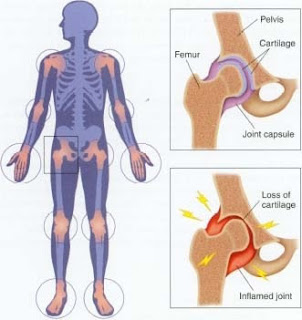The condition arthritis can be defined as the inflammation of the joints. The major symptoms of arthritis are pain in joints and inflexibility, which usually become intense with age. These are the two most common types of arthritis osteoarthritis and rheumatoid arthritis. Osteoarthritis is generally caused by normal old age and rheumatoid arthritis is an autoimmune disease. Other types of arthritis can occur due to uric acid crystals, infections and underlying disease like psoriasis. The pain due to arthritis caused by joint damage. Joints consist of the following parts:
Cartilage
Cartilage is a hard, but smooth coating on the ends of bones, cartilage permits bones of the joint to move smoothly over each other.
Joint capsule
This is a membrane which encloses all the joint parts.
Synovium
This is a thin membrane which lines the joint capsule and produces synovial fluid, which makes the joint slippery and nourishes the cartilage.
The most usual signs and symptoms of arthritis include the joints. Rely upon the type of arthritis, signs and symptoms also include:
Pain
Stiffness
Swelling
Redness
Decreased range of motion
Treatment options:
Medications
The medications used in the treatment of arthritis alter, rely upon the type of arthritis. Normally used arthritis medications contain:
Analgesics
These types of medications help in reducing pain, but these medications do not have any effect on inflammation. Examples are acetaminophen (Tylenol, others), narcotics containing oxycodone (Percocet, Oxycontin, others) and tramadol (Ultram, Ryzolt).
Nonsteroidal anti-inflammatory drugs
Nonsteroidal anti-inflammatory drugs treat both pain and inflammation. Over-the-counter nonsteroidal anti-inflammatory drugs include naproxen (Aleve) and ibuprofen (Advil, Motrin, others). Few types of nonsteroidal anti-inflammatory drugs are accessible only by prescription. Oral nonsteroidal anti-inflammatory drugs can cause stomach problems like irritation, and few may enhance the risk of heart attack and stroke. Some nonsteroidal anti-inflammatory drugs are also accessible as creams and gels, which can massage on joints.
Counterirritants
Few types of creams and ointments which contain menthol or capsaicin, these ingredients make hot peppers spicy. Massaging these preparations on the skin over the aching joint may obstruct the transmission of pain signals from the joint itself.
Disease-modifying antirheumatic drugs
Disease-modifying antirheumatic drugs are often used in the treatment of rheumatoid arthritis. Disease-modifying antirheumatic drugs decrease or stop the immune system from attacking the joints. Examples are hydroxychloroquine (Plaquenil) and methotrexate (Trexall).
Biologics
These are commonly used in combination with disease-modifying antirheumatic drugs, biologic response modifiers are genetically made drugs that aim many protein molecules that are included in the immune response. Examples are infliximab (Remicade) and etanercept (Enbrel).
Corticosteroids
This type of drug, includes cortisone and prednisone, and decreases inflammation. Corticosteroids can be used orally or also used in the form of injections directly into the painful joint.
Therapy
Physical therapy can be effective for some types of arthritis. Exercises can improve the motion and strengthen the muscles surrounding joints.
Surgery
If other treatment options do not work so surgery is the only cure.
Joint replacement
In this procedure doctors remove the damaged joint and replaces it with an artificial joint. Joints of hips and knees are most commonly replaced.
Joint fusion
This procedure is common for smaller joints like joints in the wrist, joints in the ankle and fingers. It usually removes the ends of the two bones in the joint and then fix those ends together until they heal into one stiff unit.
Home remedies
Weight loss
Losing weight will decrease the stress on the weight-bearing joints. This may enhance the mobility and prevent future joint injury.
Exercise
Exercising can help in keeping joints flexible. Swimming is usually a good choice because the buoyancy of the water decreases stress on weight-bearing joints.
Heat and cold
Heating pads or ice packs may help in reducing arthritis pain.
Assistive devices
Using walkers, raised toilet seats and other assistive devices can help in protecting the joints and enhance the ability to perform daily tasks.









No comments:
Post a Comment